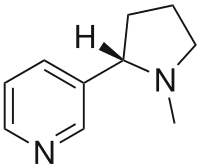
Photo from wikipedia
α6β4 nAChR is expressed in the peripheral and central nervous systems and is associated with pain, addiction, and movement disorders. Natural α-conotoxins (α-CTxs) can effectively block different nAChR subtypes with… Click to show full abstract
α6β4 nAChR is expressed in the peripheral and central nervous systems and is associated with pain, addiction, and movement disorders. Natural α-conotoxins (α-CTxs) can effectively block different nAChR subtypes with higher efficacy and selectivity. However, the research on α6β4 nAChR is relatively poor, partly because of the lack of available target-specific α-CTxs. In this study, we synthesized a novel α-4/7 conotoxin QuIA that was found from Conus quercinus. We investigated the efficacy of this peptide to different nAChR subtypes using a two-electrode voltage-clamp technique. Remarkably, we found α-QuIA inhibited the neuronal α3β2 and α6/α3β4 nAChR subtypes with significantly high affinity (IC50 was 55.7 nM and 90.68 nM, respectively), and did not block other nAChR subtypes even at a high concentration of 10 μM. In contrast, most α-CTxs have been determined so far to effectively block the α6/α3β4 nAChR subtype while also maintaining a similar higher efficacy against the closely related α6β2β3 and/or α3β4 subtypes, which are different from QuIA. In conclusion, α-QuIA is a novel α4/7-CTx, which has the potential to develop as an effective neuropharmacology tool to detect the function of α6β4 nAChR.
Journal Title: Marine Drugs
Year Published: 2022
Link to full text (if available)
Share on Social Media: Sign Up to like & get
recommendations!